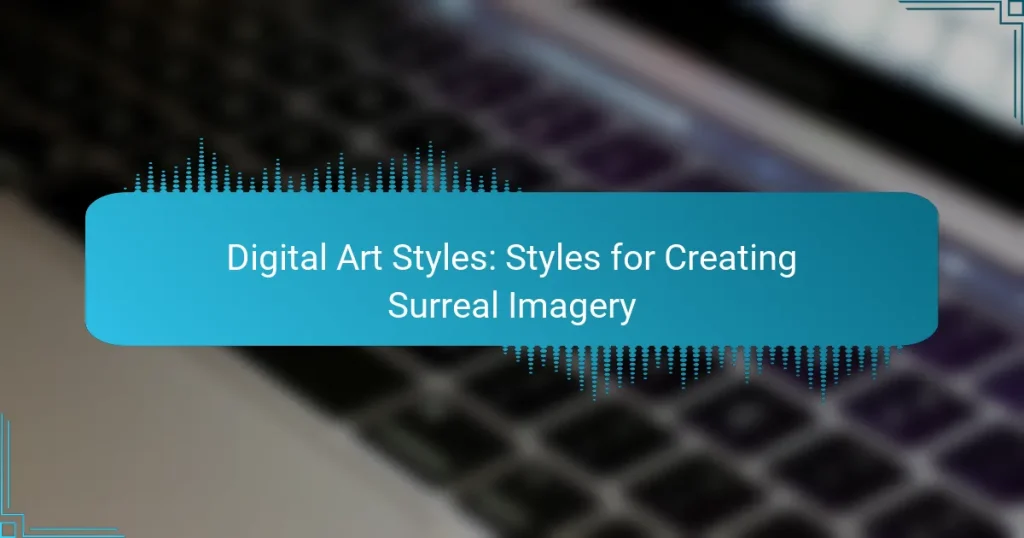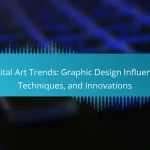Digital art styles for creating surreal imagery allow artists to merge reality with imagination, resulting in dreamlike visuals that evoke deep emotions. By utilizing techniques such as abstraction and innovative compositions, artists can challenge perceptions and convey complex concepts. Selecting the right style is crucial, as it directly influences the viewer’s experience and the emotional impact of the artwork.
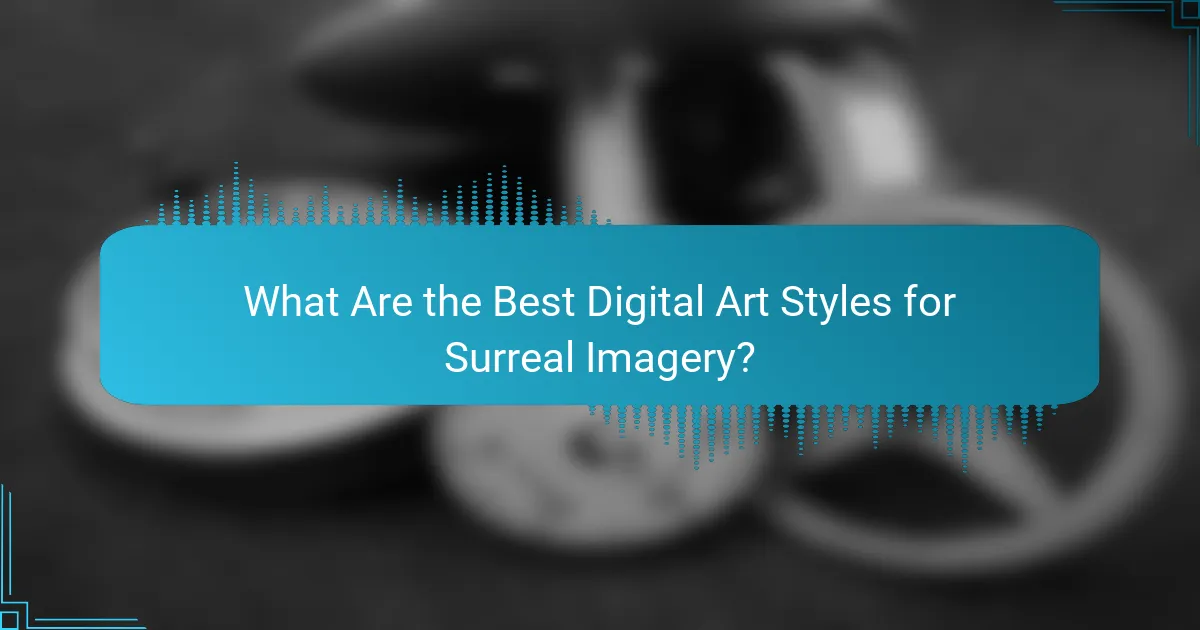
What Are the Best Digital Art Styles for Surreal Imagery?
The best digital art styles for creating surreal imagery include techniques that blend reality with imagination, allowing artists to explore dreamlike concepts. These styles often emphasize abstraction, manipulation, and innovative compositions to evoke emotions and challenge perceptions.
Abstract Expressionism
Abstract Expressionism in digital art focuses on spontaneous, automatic, or subconscious creation. Artists use bold colors, dynamic shapes, and gestural marks to convey emotions rather than represent reality. This style is effective for surreal imagery as it allows for personal interpretation and emotional depth.
To create abstract expressionist pieces, experiment with digital brushes that mimic traditional media. Layering colors and textures can enhance the emotional impact of the artwork. Consider using software like Adobe Photoshop or Procreate, which offer a variety of tools for this style.
Dreamlike Realism
Dreamlike Realism combines realistic elements with surreal, fantastical components to create a sense of otherworldliness. This style often features hyper-detailed subjects placed in unusual or impossible settings, blurring the line between reality and fantasy.
When working in this style, focus on lighting and perspective to enhance the dreamlike quality. Incorporating unexpected juxtapositions, such as placing familiar objects in strange contexts, can evoke a sense of wonder. Use high-resolution images for clarity and detail in your compositions.
Digital Collage
Digital Collage involves combining various images, textures, and graphics to create a cohesive artwork. This technique is particularly effective for surreal imagery as it allows for the juxtaposition of disparate elements, creating new narratives and visual experiences.
To create a digital collage, gather a variety of images that resonate with your theme. Use layering techniques to blend these images seamlessly, adjusting opacity and applying filters for a unified look. Software like Canva or Adobe Photoshop can facilitate this process with their user-friendly interfaces.
Photo Manipulation
Photo Manipulation is the process of altering photographs to create surreal effects. This technique can involve changing colors, adding or removing elements, and distorting images to achieve a desired surrealistic outcome.
When manipulating photos, pay attention to the composition and balance of the final image. Use tools like Adobe Photoshop to cut out elements and blend them into new backgrounds. Ensure that lighting and shadows match across elements to maintain realism, even in a surreal context.
3D Rendering
3D Rendering involves creating three-dimensional objects and environments using software. This style allows artists to explore complex shapes and perspectives, making it suitable for surreal imagery that requires depth and spatial manipulation.
To get started with 3D rendering, use programs like Blender or Autodesk Maya. Focus on experimenting with lighting and textures to enhance the surreal quality of your scenes. Consider incorporating unusual proportions or gravity-defying elements to amplify the dreamlike effect.
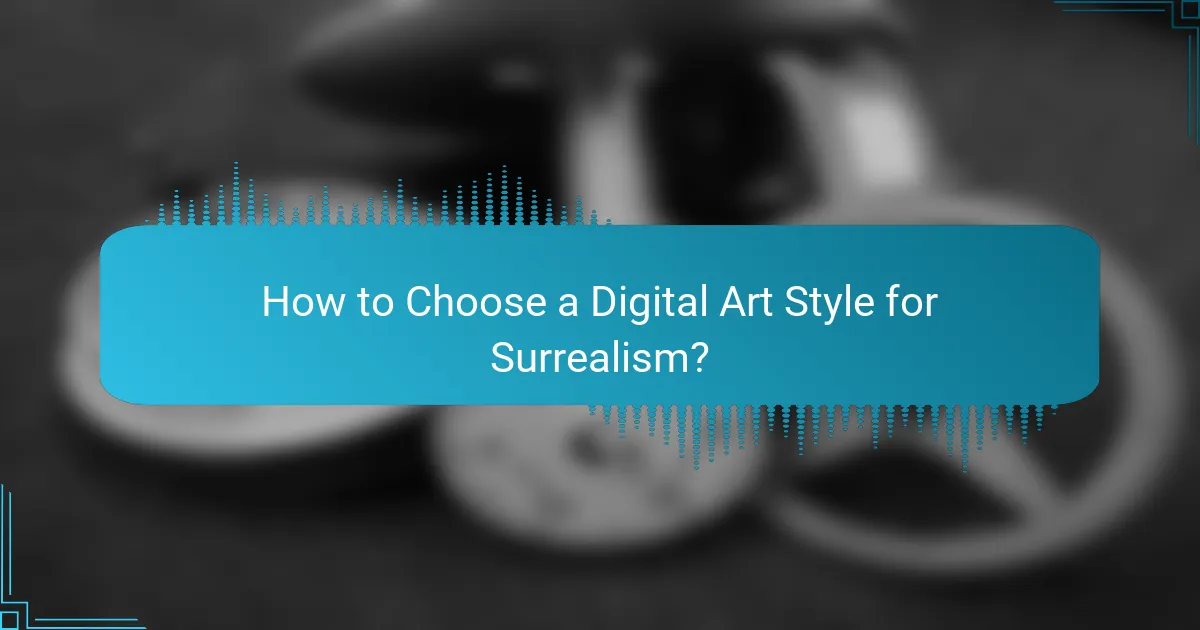
How to Choose a Digital Art Style for Surrealism?
Choosing a digital art style for surrealism involves aligning your artistic vision with techniques that enhance dreamlike or fantastical elements. Consider what emotions or concepts you want to convey, as different styles can significantly impact the viewer’s experience.
Consider Your Message
Your message is the foundation of your surreal artwork. Determine the themes or emotions you wish to express, such as dreams, fears, or the subconscious. For instance, if you want to explore the theme of isolation, a darker, more abstract style may be appropriate.
Think about how different styles can convey your message. A vibrant, colorful approach might evoke joy, while muted tones could suggest melancholy. Experimenting with various styles can help you find the one that best communicates your intended message.
Evaluate Your Skills
Your existing skills will influence which digital art styles you can effectively implement. If you are comfortable with detailed illustrations, styles that require intricate line work may suit you. Conversely, if you are a beginner, simpler styles that focus on color and composition might be more manageable.
Consider taking online courses or tutorials to enhance your skills in specific styles. This can help you expand your artistic repertoire and find a surreal style that resonates with your abilities and interests.
Assess Available Tools
The tools you have access to can significantly affect your choice of digital art style. Software like Adobe Photoshop or Procreate offers a wide range of brushes and effects that can enhance surreal imagery. Familiarize yourself with the capabilities of your tools to see what styles they can support.
Additionally, consider hardware such as graphics tablets, which can improve your precision and control. Investing in quality tools can elevate your work and allow for more complex techniques, making it easier to achieve the surreal effects you desire.
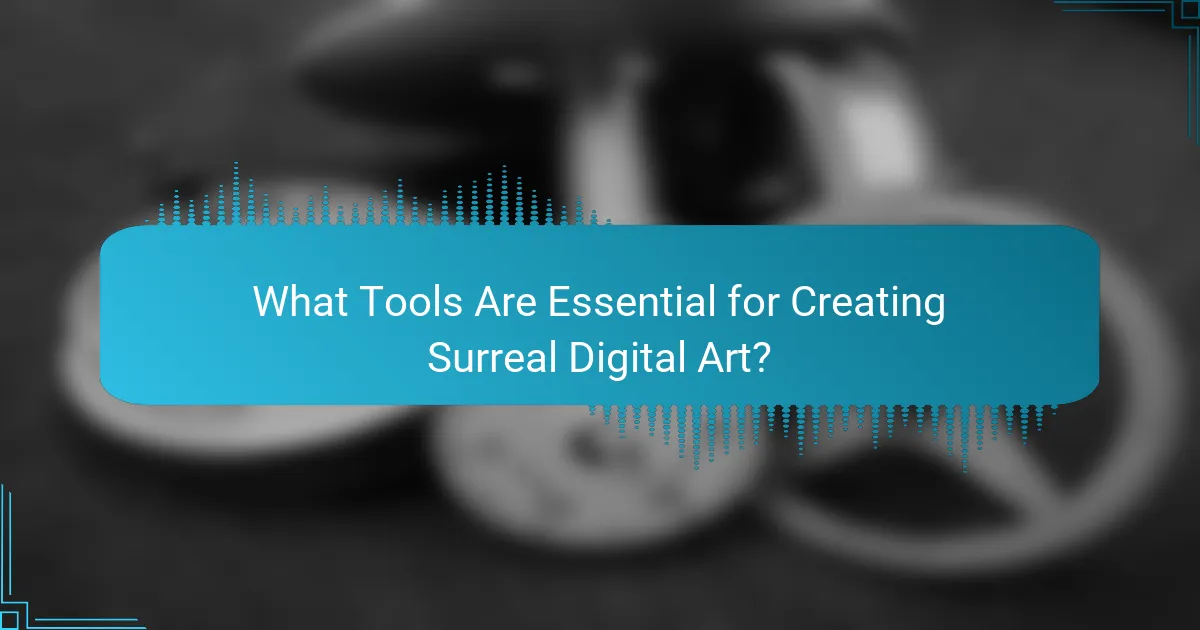
What Tools Are Essential for Creating Surreal Digital Art?
To create surreal digital art, essential tools include software that offers flexibility, advanced features, and a user-friendly interface. Popular choices among artists are Adobe Photoshop, Procreate, Corel Painter, and Blender, each providing unique capabilities for crafting imaginative visuals.
Adobe Photoshop
Adobe Photoshop is a leading choice for digital artists due to its extensive range of tools and features tailored for photo manipulation and digital painting. Its layer-based editing allows for complex compositions, making it ideal for surreal imagery where blending and layering elements are crucial.
Artists can utilize various brushes, filters, and adjustment layers to create dreamlike effects. Additionally, Photoshop supports high-resolution canvases, enabling detailed artwork suitable for print or digital display.
Procreate
Procreate is a popular app among digital artists, especially on the iPad, due to its intuitive interface and powerful brush engine. It offers a wide variety of customizable brushes and tools that allow for freehand drawing and painting, making it perfect for creating surreal art on the go.
With features like layering, blending modes, and animation capabilities, Procreate enables artists to experiment with different styles and techniques. Its affordability and ease of use make it accessible for both beginners and experienced artists.
Corel Painter
Corel Painter is designed specifically for digital painting and offers a vast array of realistic brushes and textures that mimic traditional media. This software is particularly effective for artists looking to create surreal landscapes or intricate details that require a painterly touch.
Its unique features, such as the ability to create custom brushes and use a variety of canvas textures, allow for a high degree of artistic expression. Corel Painter is well-suited for artists who prefer a more traditional painting experience in a digital format.
Blender
Blender is a powerful open-source 3D modeling and animation software that can also be used to create surreal digital art. Its capabilities extend beyond 3D modeling to include sculpting, texturing, and rendering, making it a versatile tool for artists interested in surrealism.
With Blender, artists can create complex 3D environments and characters, allowing for a unique blend of digital painting and 3D art. The software’s extensive community and resources provide ample tutorials and support for those looking to explore surreal imagery in three dimensions.

What Techniques Enhance Surreal Digital Art?
Techniques that enhance surreal digital art include layering and blending, color manipulation, and perspective distortion. These methods allow artists to create dreamlike visuals that challenge reality and evoke strong emotions.
Layering and Blending
Layering involves stacking multiple images or elements to create depth and complexity in surreal art. Artists can use software like Photoshop to adjust the opacity and blending modes of each layer, allowing for seamless integration of disparate elements.
Consider using a variety of textures and images to build a rich visual narrative. For instance, combining a landscape with abstract shapes can produce striking contrasts that enhance the surreal quality of the artwork.
Color Manipulation
Color manipulation is crucial for setting the mood in surreal digital art. Artists can alter hues, saturation, and brightness to create an otherworldly atmosphere. For example, using vibrant, unnatural colors can evoke feelings of unease or wonder.
Experimenting with color gradients and filters can also help in achieving unique effects. A common technique is to apply a color overlay to unify the composition while still allowing individual elements to stand out.
Perspective Distortion
Perspective distortion plays a vital role in creating surreal imagery by altering the viewer’s perception of space and scale. Techniques such as skewing or warping elements can make familiar objects appear strange and disorienting.
Using exaggerated vanishing points or unconventional angles can enhance the surreal effect. For instance, depicting a landscape where the horizon bends unnaturally can challenge the viewer’s sense of reality and provoke thought.

What Are the Key Trends in Surreal Digital Art?
Surreal digital art is increasingly influenced by technological advancements and innovative techniques. Key trends include AI-generated art and augmented reality integration, which push the boundaries of creativity and viewer engagement.
AI-Generated Art
AI-generated art utilizes algorithms and machine learning to create unique visual pieces. Artists can input parameters or styles, and the AI generates images that reflect those inputs, often resulting in unexpected and surreal outcomes.
When exploring AI-generated art, consider tools like DALL-E or Midjourney, which allow for a wide range of artistic expression. However, it’s essential to maintain a balance between human creativity and machine output to ensure the final piece resonates with viewers.
Augmented Reality Integration
Augmented reality (AR) integration in surreal digital art enhances the viewer’s experience by overlaying digital elements onto the physical world. This technology allows artists to create immersive environments where users can interact with surreal imagery in real-time.
To effectively use AR in your art, consider platforms like Adobe Aero or Artivive, which facilitate the creation of AR experiences. Keep in mind that accessibility and user engagement are crucial; ensure that your AR elements are easy to access and navigate for a broader audience.
